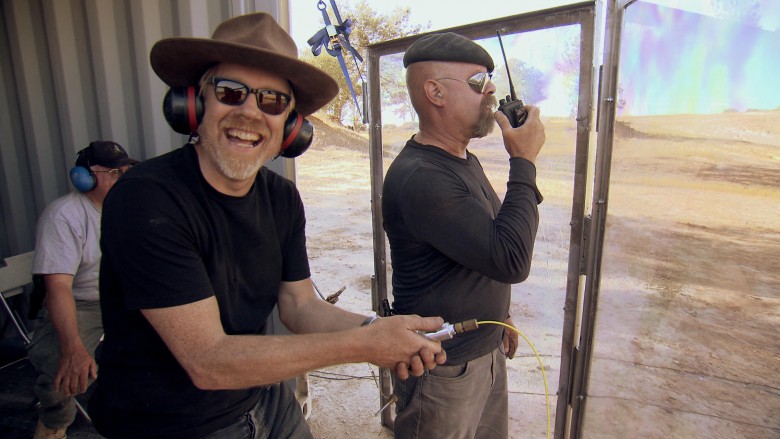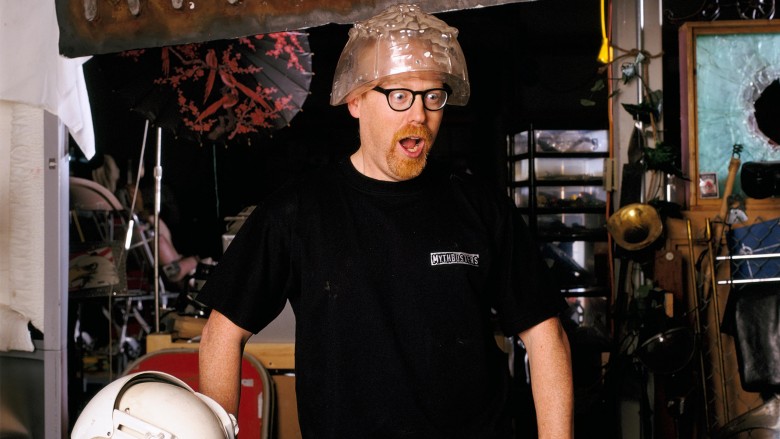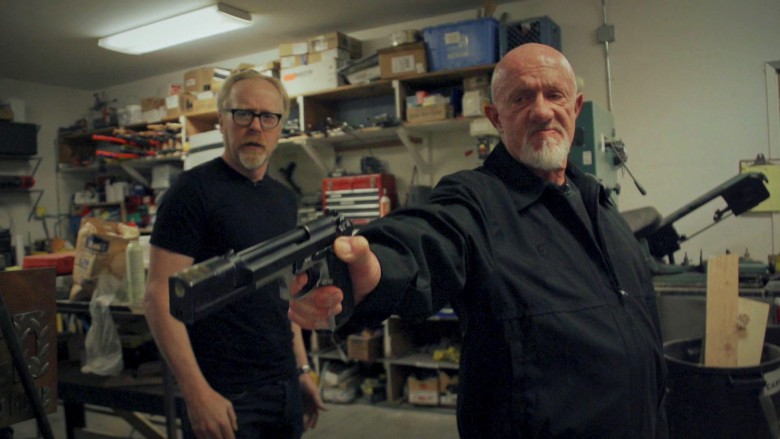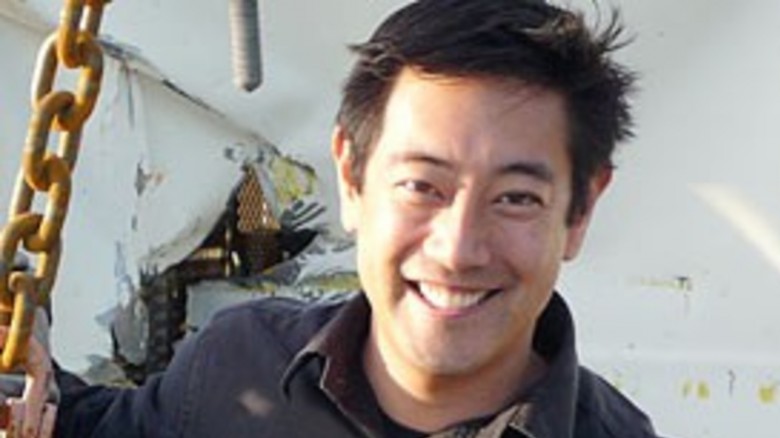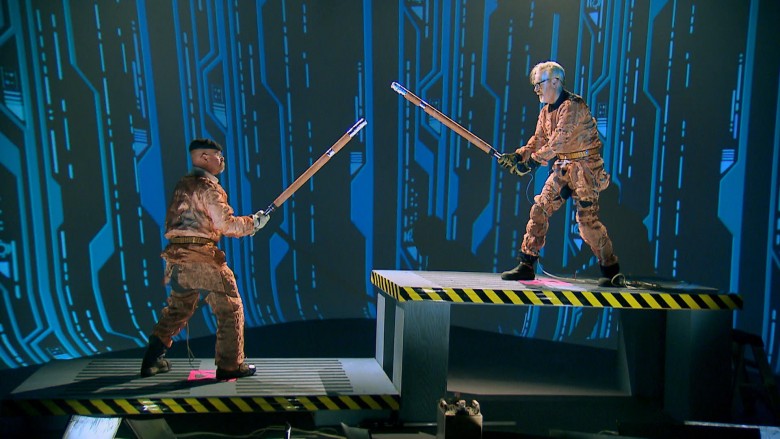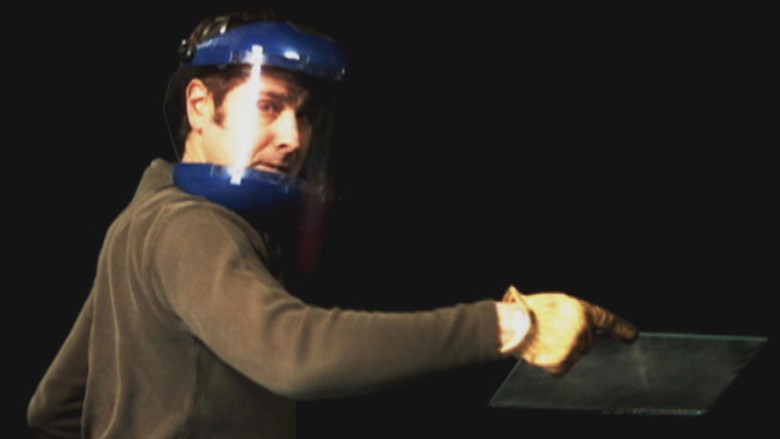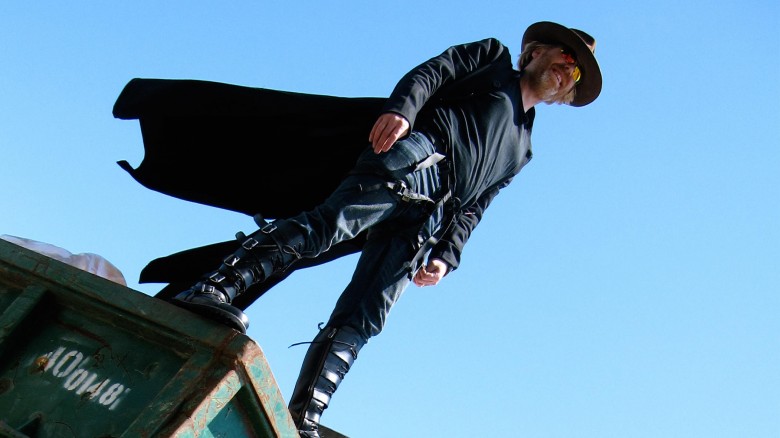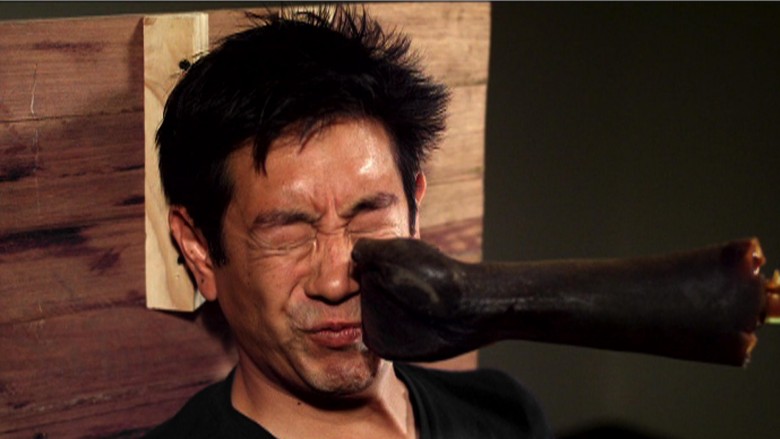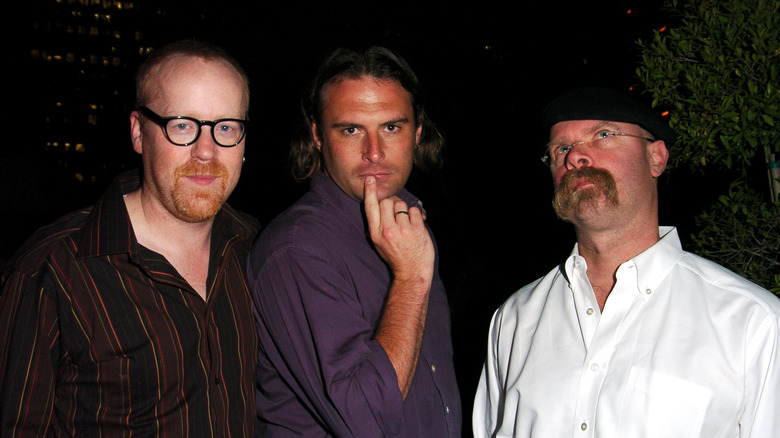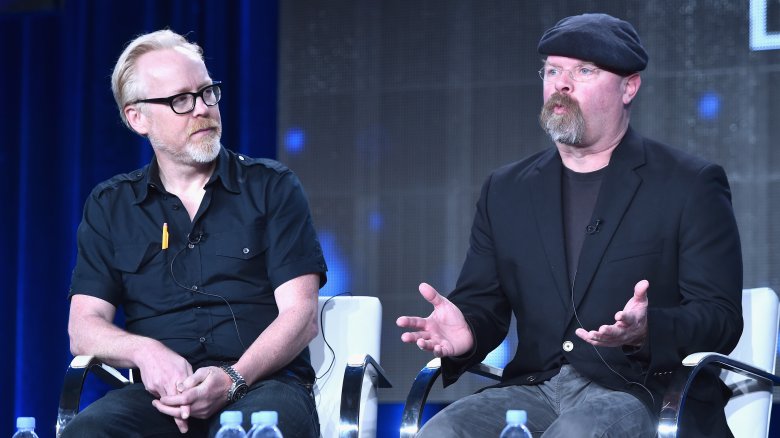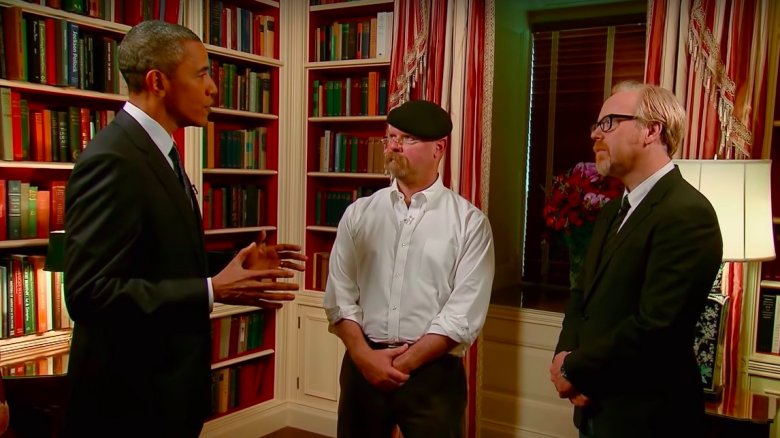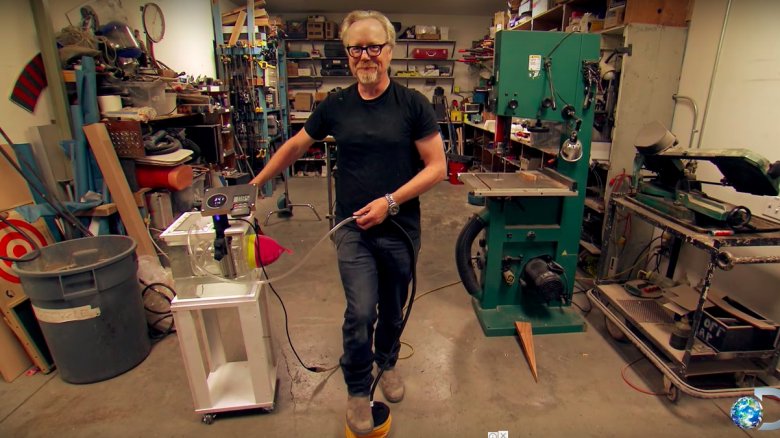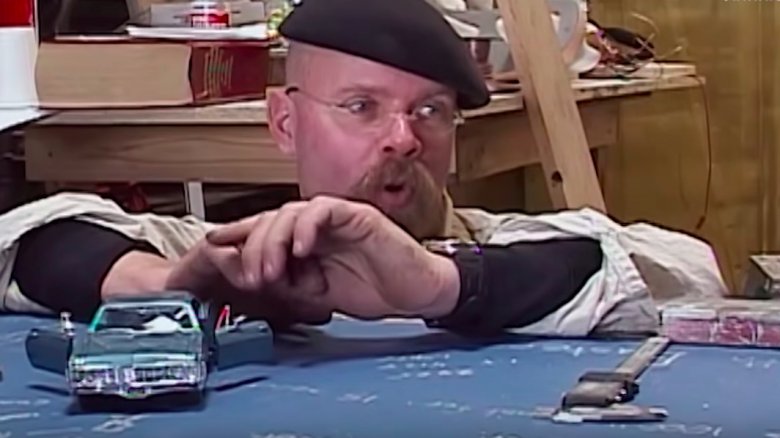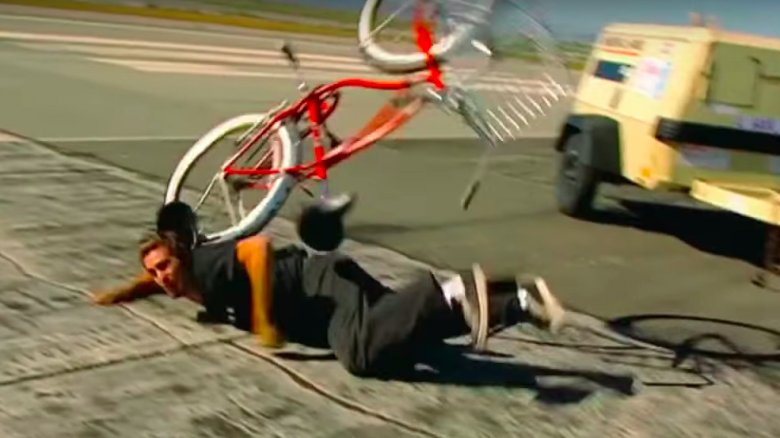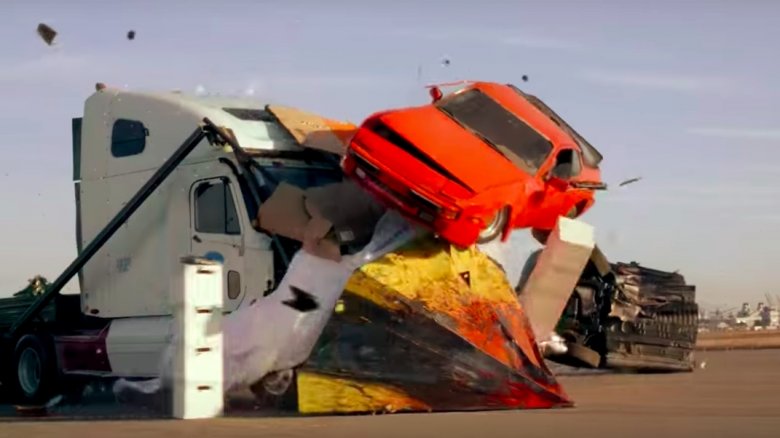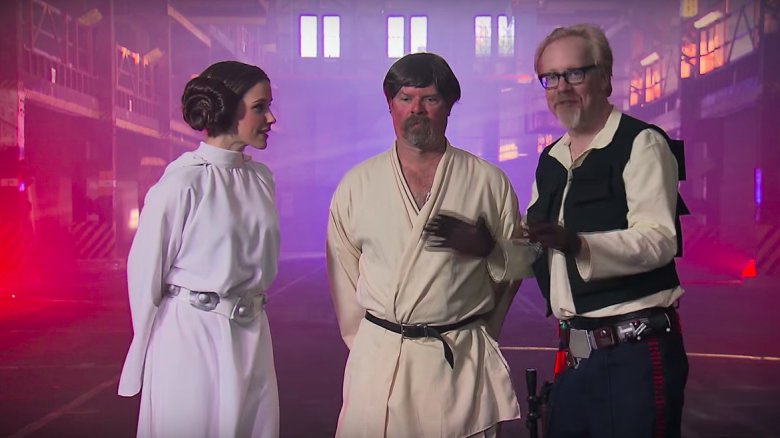The Untold Truth Of MythBusters
Anyone who loves science and lived through the last couple decades probably knows and loves the Mythbusters. But you didn't have to be a nerd to appreciate the show — you could also be into explosions or car crashes or watersports or daring stunts, or you could just be a fan of sticking it to the man and proving people wrong.
It didn't take the Mythbusters long to become myths themselves. Their show ran for a whopping 14 seasons, and the public soon fell in love with both the busting and the busters. But because of that widespread love and popularity, many people might think they know all the secrets behind the making of this explosively entertaining show. However, there were a few secrets the Mythbusters cast kept to themselves after the cameras stopped rolling, just waiting for the right fans to discover. Here's the untold truth of Mythbusters.
They have destroyed evidence of what they found
The Mythbusters were clearly never strangers to destroying things. Invariably, testing various myths turned into an excuse to blow something up, so as to demonstrate amazing things for their fans. However, there was one time where they used their destructive power to hide something from the fans, instead of sharing it with them. What was it? Ironically enough, it was an explosive, AKA their bread and butter.
The cast was understandably cagey when it came to talking about this, but at the Silicon Valley Comicon in 2016, Adam Savage talked about their investigation of an "easily available material and its supposed explosive properties." Savage reported that their discovery was "so explosive" and easy to make, they completely destroyed any and all footage of their discovery. Plus, the cast took a vow of secrecy to never dish about the details to the public. Apparently, the tech-savvy team determined that destroying the footage was the only way to ensure it didn't simply pop up on YouTube a few years down the line, causing amateurs everywhere to go and blow themselves to bits.
How serious was all of this? When the Defense Advanced Research Projects Agency (DARPA) asked for assistance regarding the danger of homemade bombs, Savage actually forwarded what his team had found. To a government agency devoted to making weapons of war! The show that specializes in explosions had to use all their powers, and that of the government, to hide an explosive discovery from the world. That simply makes us want to know what this thing is more.
Adam Savage worked on Sesame Street as a kid
Over the years, Adam Savage has become a brand in and of himself, known the world over for his madcap personality and penchant for destructive mythbusting. Interestingly, though, this was not how the world was first introduced to Savage. Appropriately enough for the zany funnyman, Adam Savage made his television debut as a cartoon character on Sesame Street.
Way, way back in the day, Sesame Street included many different cartoon segments, mostly comprised of 30-second bits that ran in-between the other programming. Savage's father was behind many of these commercials, and animating them helped pay for the family home. This eventually led to a job where Savage's father had to produce 10 animations about children who — get this — were interested in figuring out how things work.
Fittingly enough for a future Mythbuster, young Savage was tapped to be one of the two children featured in these spots, He had great fun doing so, and he received residuals for years. He eventually tried his own hand at conventional animation — and even claymation — before deciding that he shouldn't follow in his father's footsteps, and would have to pursue something different. Imagine if he stayed though. Elmo would be setting bombs off in front of Oscar's can every day. It would be glorious.
Just about all of them used to work in movies
With Mythbusters running 14 seasons, it's understandable that most fans primarily associate the cast with the show that made them famous. Interestingly, though, several of them have interesting histories in Hollywood.
For instance, Jamie Hyneman helped work the special FX of the Tom Cruise hit Top Gun, and helped work on some of the animatronics in the Matrix sequels. He also owns a special FX company called M5 Industries. Adam Savage has been a model maker for the Matrix movies and Galaxy Quest, as well as Bicentennial Man (hey, work is work). Fittingly, Tory Belleci started out working for Hyneman at M5, and later worked on the Matrix movies, Galaxy Quest, and cult classic Starship Troopers. Engineering guru Grant Imahara has also worked on the Matrix movies and Galaxy Quest, as well as movies like Terminator 3 (again, work is work).
However, the main point of connection for many of the cast is Star Wars. For instance, Belleci worked at Industrial Light and Magic for years, serving as a model maker for the first two Prequels. Imahara was an engineer for ILM as well, and worked on all three prequels. Savage also worked at ILM and, like Belleci, served making models for the prequels. And, of course, Hyneman also worked on the prequels, working on the special FX team. His own FX company would later be how he got to know Belleci, eventually inviting him to join the show and get away from prequels forever.
Grant originally wanted to be a writer
It took Grant Imahara no time at all to establish himself as an engineering and robotics guru on Mythbusters, impressing the cast and viewers of the show like he had for Hollywood time and again. In fact, it's difficult to really imagine Imahra in any other role (except, perhaps, as "mad scientist").
To hear him tell it, though, there was one real dream job that got away from him, and that was to be a writer. Specifically, he wanted to be a screenwriter, and made an effort to change his major at the prestigious University of Southern California Cinematic Arts. Imahara temporarily dropped out, but at the suggestion of a sympathetic counselor, he became an assistant to Tomlinson Holman, creator of the legendary THX sound system.
A year of this mentorship showed Imahara he could still be creative as an engineer, and Holman's Industrial Light and Magic connections helped secure Imahara an internship that blossomed into a full-time job at THX and, later, ILM. If only they had let him write those Star Wars prequels. Maybe they'd find an excuse to blow up Jar-Jar.
The Mythbusters regularly fight
In 2014, the Mythbusters were making headlines in a much more negative way than usual. Rumors swirled that the two main Busters, always such a successful team onscreen, actually hated each other offscreen. Adam Savage helped clarify this a bit, but some of his details were rather striking, such as how the two have never gone to a non-work-related dinner together, and probably never would. BFFbusted?
Basically, the two consider themselves as professionals who shared a highly specific job, and they managed to get over any differences they may have in the name of accomplishing this goal. As Savage put it, "We disagree about the small details every single day—on almost every single detail. But we don't really disagree about the big stuff." Savage, ever the optimist, points out that there's an upside to having someone "always checking and challenging your work," as this brings out a greater degree of "integrity" in his work.
It's interesting to imagine, then, that some of their best work came as a result of hours of disagreements — furthermore, this reveals that some of the "playful" insults they toss each other's way on the show may actually have a real bite to them.
Tory Belleci made his own flamethrower and pipe bombs when he was younger
For most of the Mythbusters crew, mastering the art of crazy explosions was mostly a matter of keeping fans happy. After all, most of them had backgrounds in modeling, engineering, and robotics for the movie industry ... not exactly a place that encouraged them to permanently blow things up.
However, it turns out that the team had a secret weapon in the form of Tory Belleci, who had actually learned how to blow things up from a very young age. When he was giving a speech to the Davidson County Community College, Belleci let slip that, at the tender age of 11, he was not only learning how to make his own Super 8mm films (a valuable skill for the future entertainer), but making his own flamethrower, and even pipe bombs (a less-valuable skill for a future entertainer). While these are the kinds of skills that would probably get most modern children put on a governmental watch list or two, they served as valuable experience for the young man figuring out how to use the resources around him to achieve explosive entertainment.
And it certainly paid off, as a number of students asking Belleci questions afterwards admitted how much they like to see things blow up when watching Mythbusters. Keep them away from the pipe bombs.
They accidentally fired a cannonball through an occupied home
Normally, the Mythbusters team are known as paragons of safety. Not only do they give that firm "do not try this at home" warning to their viewers, but they operate in conjunction with local law enforcement and emergency services, to make sure their mythbusting doesn't do any real damage. Remarkably, in 14 seasons of the show, they screwed up very few times, but one of those occasions was a doozy, involving the team nearly destroying somebody's home!
For one experiment in the San Francisco area, the team were testing myths related to homemade cannons. For safety's sake, the team had set up water vats that were supposed to safely catch the cannons, so nothing dangerous happened. Unfortunately, they experienced what Discovery later hilariously dubbed "an unforeseen bounce," when a cannonball blew through the cinder-block wall on the set of the show. It ended up going on a rather amazing journey, in which it flew through somebody's front door, up their stairs, through their bedroom (while they were in there), and out of their house before jumping a thoroughfare, hitting the top of another home, and coming to a final rest by slamming into a minivan.
Fortunately, nobody was hurt, just the minivan. And nothing of value was lost.
Kari Byron is an explosive artist, literally
While much of the Mythbusters crew ended up doing work that might be considered artistic, like model-making for major Hollywood films, Kari Byron is the only one of the main cast with formal training in this area. She was a student of film and culture at San Francisco State University who was eager to join the special FX industry, which is what eventually led her to Jamie Hyneman's M5. She was actually an unpaid intern for a while, which eventually blossomed into a job offer to join Mythbusters.
She never really lost her artistic streak, though — if anything, she learned to marry the more explosive elements of the show into her own artistic expression. One great example is her creation of explosive paintings. It's not exactly what it sounds like — she lights gunpowder on fire and then scrapes burnt clay away from her page, creating spooky images like the outline of a burnt and screaming face (think Munch meets Mythbusters). She described the experience as "controlled chaos" and said that "It's a little bit of controlling the wildness of the explosion. And I've grown to like explosions over the years."
It's good to know that, when not on the clock, Byron doesn't blow things up in the name of science — instead, she blows things up in the name of art.
Adam Savage only regrets one 'magical' myth
Of the hundreds of myths the group has tried to bust over the years, are there any they wish they had simply walked away from? Interestingly, Adam Savage identified only one such myth, and not because it was dangerous or hard to film. Instead, it's because it involved magic.
At least, that's how Savage saw it. The experiment itself involved determining whether keeping a shaving razor beneath a pyramid would actually keep it sharper, due to so-called "pyramid power." Savage regrets the segment, because he believes it was impossible for them to ever truly apply the scientific method to that particular experiment. He believed that they were tasked with "trying to prove a negative" that had no control against which they could measure success or failure. That and lifting up the Pyramids of Giza to stick a razor blade underneath was such a pain.
Entertainingly, Savage compared the experiment to scientific endeavors to find Bigfoot, which too could only prove that the researchers can't find Bigfoot — this absence isn't proof of his existence anymore than a razor's sharpness can prove or disprove the existence of magic. No matter what Gillette wants you to believe.
Grant Imahara received a social media backlash for advertising McDonald's
Due to the special role they hold in the public eye, most of the Mythbusters team have shied away from any kind of corporate involvement or sponsorship. Because their show is supposed to be based around rigorous scientific testing, the public is likely to assign a certain weight to endorsements they make, and these endorsements, in all likelihood, don't receive the kind of rigor their experiments receive.
All of this serves to partially explain why Grant Imahara received a lot of online criticism for his appearance in commercials involving McDonald's products. It was an interesting case of McDonald's overreacting to certain criticisms of their products. For instance, many people are wary of the machine-separated-meat they use, not-so-affectionately referring to it as "pink slime." So, these commercials featured Imahara "mythbusting" McDonald's myths, saying that chicken nuggets aren't made from this "pink slime" and that, contrary to bizarre rumors, McRibs don't contain eyeballs or lips.
However, the ads were arguably a case of denials sounding way too specific, as people who had never heard bizarre myths about eyeballs in their McRibs were now, well, eyeballing their food choices more carefully. And social media had a field day, criticizing Imahara for selling out in the wake of being fired from Mythbusters. Fortunately, his new show on Netflix, The White Rabbit Project, should keep Imahara for busting anymore McDonald's myths, like the one about Mayor McCheese imprisoning children in playgrounds around the world, without ever charging them with anything.
The show's whole premise used to be very different
Originally, Mythbusters was going to be quite literal, exploring things like well-known urban legends and actual myths. Over time, though, they dropped that idea, becoming more focused on what their viewers would like to see. After all, the customer is always right, and there are only so many real myths to bust, anyway.
Hence, some of the fan-favorite episodes explore whether certain movie scenes could realistically happen, or whether MacGyver could realistically escape certain death time and time again. While these are definitely sillier concepts than the original premise of the show, Savage seems happy focusing on any "misconception about the way the physical world works." In a world dominated by improbable blockbuster movies and amazing (and possibly fake) YouTube clips, there's a lot of confusion, which gave the Mythbusters a lot of material to work with. And if they ever come back, they'll still have plenty to work with, because we're just as confused now as we were then.
No advertisers were harmed in the making of this episode
Mythbusters was all about science, which means it never let a little thing like corporate sponsorship get in the way of scientific truth. Right? Sigh. As it turns out, even Mythbusters wasn't immune to advertiser pressure, or at least that's the impression they gave when they decided to ax an entire episode about RFID, that handy technology that lets you wave your credit card in front of a card reader so you don't have to bother with the arduous task of swiping it.
You've probably heard rumors that RFID isn't very secure. Well, Mythbusters got wind of that, too, and planned an entire episode about the hackability of the technology. But according to the Register, lawyers for major credit card companies intervened, and plans had to be sacked. "They made it really clear to Discovery that they were not going to air this episode talking about how hackable this stuff was," Adam Savage told a Hackers on Planet Earth conference. "Discovery backed down being a large corporation that depends upon the revenue of the advertisers."
That seemed like the honest truth, but evidently advertisers can also gag hosts from talking about being gagged by advertisers (at least it sort of looks that way) because Savage later backtracked, saying, "The decision not to continue with the RFID story was made by our production company ... and had nothing to do with Discovery or their ad sales department." Whatever you say, Adam.
It's just in the name of science, we swear
If you've ever thought that maybe Mythbusters danced a little too close to mad science stuff, don't worry, it's not like they ever received executive orders to build a death ray or anything. Except for that one time, when President Obama literally gave them orders to build a death ray. Yes, in a 2010 Mythbusters episode, the president gently admonishes Savage and Hyneman for their failure to thoroughly test the Archimedes solar ray (a myth they busted in 2006), a death ray device that dates all the way back to the second century.
According to Gizmodo, the president's appearance on Mythbusters was actually part of a White House initiative to get kids more interested in science, and let's face it, death rays are super productive science experiments, especially in the hands of adolescent children.
The Archimedes solar ray was an ancient, probably mythical device that was supposed to ignite the sails of enemy ships with highly focused mirrors. To retest the myth, the team recruited 500 people with mirrors, but failed to once again to prove the concept. Hyneman did say the reflections were really distracting, though, so it's possible the death ray did have some sort of functional purpose, just not, you know, a flammable one.
You can't say 'fart' on TV
Mythbusters has always been billed as a "family show," which means there are certain things the Mythbusters just aren't allowed to do, like show a simulated body part while testing the "peeing on the third rail myth," even though said body part was literally an artificial tube.
According to TV Tropes, censors once prohibited the Mythbusters from airing an entire episode about farts, because, you know, farts. Undeterred, the team tried again, only this time they followed all sorts of oddball rules, like only using the word "flatus," instead of "fart," which supposedly made the whole endeavor more scientific or something.
They were also limited to showing only certain things when discussing farts, specifically, not butts. One of their final episodes asked the question, "Can you see a fart on a thermal imaging camera?" but instead of taking the easy way out, which would have been, you know, filming someone's butt with a thermal imaging camera, the Mythbusters had to build a fart machine to perform the exact same natural function that every single human being already performs about 14 times a day. Fortunately, the result was really funny and actually sort of vulgar even though it was just a whoopie cushion, so take that, censors.
Tall tales or what now?
All shows have an origin story, and the Mythbusters origin story is full of nuclear accidents, spider bites, and Jamie Hyneman being raised by condors. Not really any of those things, actually, in fact the original proposed name of the series wasn't even that cool. Series creator Peter Rees originally pitched the series as "Tall Tales or True," and the early incarnation of the idea was mostly just that it would be a retelling of tall tales and urban legends. Discovery turned Rees down, which isn't that surprising since the concept was clearly missing that spark that makes a good idea become a groundbreaking series.
Anyway, Rees went back to the drawing board and reimagined the show with a science element, and finally got a nibble — Discovery agreed to do three test episodes. Jamie Hyneman, who was one of several special effects pros recruited as potential hosts, got his one-time coworker Adam Savage to come on board because Hyneman wasn't sure he could carry the whole show on his own.
"Mythbusters was the last thing I ever thought would take off," Hyneman told DesignNews. "Urban legends had no special interest to me. After the first three episodes I figured it was over because that was about all I knew of urban myths." Now, Jamie Hyneman is known for his methodological precision, but it's pretty clear no one has ever been quite so wrong.
Injury was practically part of the job description
The Mythbusters had some very public mishaps, but what's less known is how common it actually was for them to injure themselves in the line of duty. According to CNet, Mythbuster accidents ran the gamut from explosions all the way to injury by goat. In fact Adam Savage once said the show was "four minutes of science and 10 minutes of me hurting myself."
In one infamous experiment, the team wanted to find out if an explosion could "literally 'knock the socks off'" a mannequin. So they ignited a quarter ton of ammonium nitrate, which shattered the windows of a nearby home. Ironically, the explosion literally knocked a woman off her couch, which is sort of like knocking the socks off a mannequin, but not really.
Co-host Tory Belleci's on-set accidents included getting kicked in the crotch by a goat, and wiping out spectacularly while trying to jump over a red wagon on a bicycle. Savage was the recipient of one of the show's more serious injuries — he once broke his hand on a bulletproof safety shield. But surprisingly, most of the injuries requiring actual medical attention were fairly minor — just stitches and broken fingers. That's not bad for a show with a premise that's firmly grounded in blowing stuff up. Hopefully, the safety experts were well-compensated. No one deserved that paycheck more.
Mythbusters fans were uncredited showrunners (sort of)
The original Mythbusters lasted 14 seasons, which is remarkable not just because shows don't tend to last that long in general, but because the show's success depended on its ability to present fresh material on a consistent basis. So how exactly did showrunners manage to come up with so many different myths (more than 1,000) over its 14-year run?
Partly because of the fans. According to Freakonomics, around 25 percent of Mythbuster myths that were tested on the show were submitted by fans — in fact in one interview toward the end of the show's run, Adam Savage said it was more like 30 percent.
Savage told Freakonomics that the Mythbusters staff was really diligent about reading everything fans sent to them, from the message boards on the Discovery Channel website to old-fashioned fan mail. Mythbusters did a whole show about big rig myths based almost entirely on one letter from a fan. And the "shooting fish in a barrel" myth was a fan suggestion, too.
It tempting to think that at some point the ideas would have dried up, but would they have? New urban legends crawl out of the primordial internet so frequently that they're practically their own species. So really, with the help of fans Mythbusters probably could have gone on forever. If only Savage and Hyneman could have endured.
Article 7: The twerking of Stormtroopers is prohibited
Mythbusters was a geeky show. You can gloss over that fact as much as you like, but pretty much every cast member was unabashedly geeky and if you watched the show, you were pretty geeky, too. And what's the holy grail of geekdom? Star Wars. Obviously.
It probably won't come as much of a surprise to hear that it's not exactly simple to work something like Star Wars into your mythbusting franchise — Star Wars is a closely guarded property, and there are hoops that must be jumped through before you can start busting lightsaber and stormtrooper myths. But Savage told Hollywood Reporter that he was actually surprised by how open Lucasfilm was with their permissions — the team wasn't allowed to animate lightsaber effects, but other than that, they were given pretty free rein.
There was one additional apparent caveat, although it's pretty clear Savage was being cheeky when he said so — evidently, twerking stormtroopers were also off the table. "They wanted to make sure that we weren't going to do something too far off from what a character would do," he said. "I don't think they wanted us to twerk with a Stormtrooper or something like that." Twerking probably wasn't explicitly in the contract, though ... probably.

